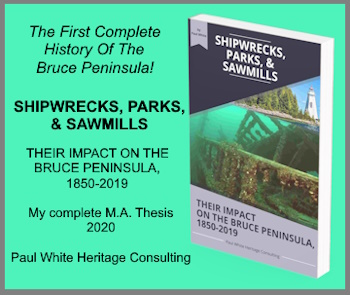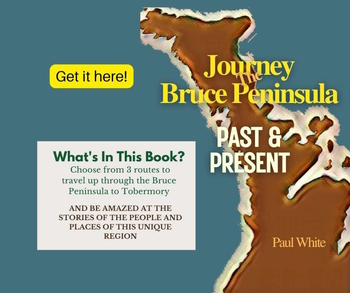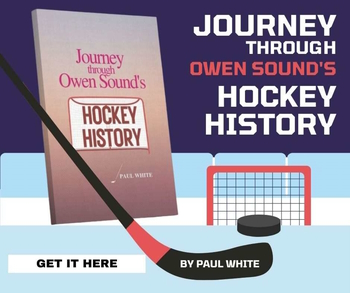Owen Sound Harbour – A Photographic History
A Review
As a historian who has written extensively about the Georgian Bay region and Owen Sound in particular, Owen Sound Harbour – A Photographic History, by Robert A. Cotton is a book that perks my historiographical curiosity.
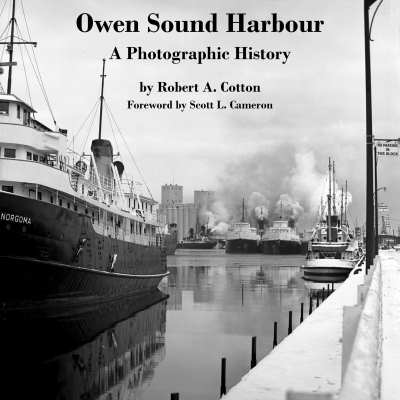 Owen Sound Harbour-A Photography History
Owen Sound Harbour-A Photography History
Robert A. Cotton
Historians have barely touched the rich heritage of the Georgian Bay region. And, most of the limited number of publications about the history of the area have depended almost entirely upon words to tell the story of their research into their subject.
Consequently, Robert Cotton has provided a new vehicle to tell the story of Owen Sound harbour, images. They say that a picture is worth one thousand words. Therefore, if my math is correct, Robert Cotton has created a historical piece of more than one hundred thousand words!
Why is a book about Owen Sound harbour important?
From the 1880s through to the 1950s, Owen Sound was a primary destination for shipping traffic on the upper Great Lakes. Consequently, Cotton’s use of pictures to describe the vessels that sailed to, and from, this important Georgian Bay port provides not only a unique perspective on maritime commerce in the region, but is also a valuable contribution to the historiography of Georgian Bay and the study of Great Lakes maritime history.
About the Book
Owen Sound Harbour – A Photographic History by Robert A. Cotton is a visual record, 117 black & white photographs, of the schooners, steamers and lake boats that came through the harbour and the role they and the harbour played in the development of shipping on the Great Lakes. Each image is accompanied with a story that highlights some aspect of the boat’s history and provides some historical context.
The book covers the years 1867, with the building of the Francis Smith, to the 1960s when the vessels of the Hindman Transportation company fleet moored in the harbour.
The Frances Smith (launched April 30, 1867) made daily runs from Owen Sound to Collingwood carrying passengers, cargo and most importantly, mail. She departed from Boyd’s Wharf at 7 a.m. and after stopping at Cape Rich and Meaford, and arrived in Collingwood in time for passengers to board the afternoon train to Toronto.
 Frances Smith Docked at Boyd's Wharf
Frances Smith Docked at Boyd's Wharf
Owen Sound Harbour
by Robert A. Cotton
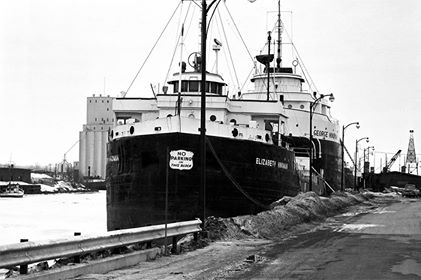 Elizabeth (foreground) and George Hindman (background) in Owen Sound Harbour
Elizabeth (foreground) and George Hindman (background) in Owen Sound Harbour
Gerry McDonald Photo Collection
Grey Bruce Image Archives
Captain Hindman found the Risacua in the Caribbean and renamed her the George Hindman (2) in 1953, she became the Elizabeth Hindman in 1962 when the larger George Hindman (3), seen docked in behind her, was purchased. After 40 years in Owen Sound the company closed at the end of the 1977 season.
These ships, with home ports scattered around the Great Lakes, docked in Owen Sound harbour during their travels. Their history tells the story of the Canadian frontier as it pushed westward beyond Georgian Bay to North Western Ontario, the Canadian prairies and the American mid-west. It also tells the story of Owen Sound’s role in that endeavour through the development of the harbour and rail facilities, of the entrepreneurs who, looking westward, financed the building of these ships, of the shipbuilders who often took their own financial risks to get the ships built and of the captains and crews who risked their lives on a daily basis navigating the treacherous upper Great Lakes.
The majority of the photographs are from the John James Collection held in Owen Sound by Grey Bruce Image Archives (GBIA). A commercial and portrait photographer in Owen Sound from 1905 until his death in 1956, James photographed well over 100 vessels and harbour scenes. The photographs have been carefully digitized from glass and film-based negatives and are some of the only records of these ships. A lovely collector’s edition for anyone interested in local history and navigation on the Great Lakes.
About the Author
Born in Guelph in 1951, Robert A. Cotton moved to Owen Sound in 1964. He received an undergraduate degree in history in 1976 at the University of Guelph where he was introduced to art, art history and photography. He studied photography at Fanshawe College and graduated from the Canadore College Journalism program in 1989. Robert has pursued careers as a photographer, museum curator and journalist. The County of Grey-Owen Sound Museum (Grey Roots) employed him as a photographer and restoration technologist and eventually he became the curator of the Billy Bishop Museum in Owen Sound. He has also worked as a photographer/writer for several newspapers. As curator of Grey Bruce Image Archives (GBIA) for the past 15 years, Robert has contributed to the publication of three pictorial history books of Owen Sound.
Where Can I Get this Great Book?
Owen Sound Harbour – A Photographic History can be ordered online at http://newpressbooks.com/shop/ for $35 plus GST and shipping and is available at the following outlets for $35 plus GST
- Foto Art Camera Shop, 842 2nd Ave East, Owen Sound, 519-376-4592
- Coles, Heritage Place Mall, 1350 16th St E, Owen Sound, ON, 519-376-4928
- Grey Roots Museum & Archives, 102599, Grey County Rd 18, Owen Sound, ON, 519-376-3690
Georgian Bay Shipping
List of Lighthouses on the Great Lakes: If you have names and/or pictures of Great Lakes Lighthouses please submit them along with details of their location.
Georgian Bay Ships: A List of all the ships that sailed on Georgian Bay until the 1960s. This list is not complete. If you know of a ship that sailed the waters of Georgian Bay please contact me with information about that vessel, and, if you have a picture that I could post with it, that would be much appreciated.
1885: A Memorable Summer Job for Owen Sound teenage boys on the Great Lakes would have historic importance, not mention a possible exciting career opportunity.
Hindman Transportation Company was a well-known Great Lakes shipping company for many years. Here you will find pictures of many of the Hindman ships
Owen Sound Harbour – A Photographic History, by Robert A. Cotton is a book that interests my historiographical curiosity.
Commercial Great Lakes Fishing It is probably safe to suggest that the commercial fishing industry was an important part of the early growth of this region.
A Georgian Bay fishing vacation has long been a popular attraction in the Bruce Peninsula region. During fishing derbies, the regional waterways are dotted with fishing boats of all shapes and sizes.
The Georgian Bay Mackinaw, designed by William Watts of Collingwood is an example of a Georgian Bay innovator creating a vessel to service the needs local mariners.
Great Lakes fishing is an asset that is protected and developed, not only for its economic potential but also for those who just enjoy spending a day by the side of a river or in small fishing boats trying to catch “the big one”!
Great Lakes Fishing History is not without its controversy. The impact of the fishing industry was such that it played an important role in the development of communities along the Georgian Bay and Lake Huron shoreline.
Georgian Bay Travel Before the Winter Freeze-Up could be a dangerous time for mariners in the early years in this region.
A Harbinger of Spring on the Great Lakes in pioneer times, was the eagerly awaited news that a lighthouse had been lit and shipping traffic could begin sailing from port to port.
Lumber Hookers Lumber hookers and tugs were an important innovation to improve the transportation of lumber on Georgian Bay.
Mapmakers on Georgian Bay were also explorers. They mapped the Georgina Bay shoreline noting safe harbours, dangerous reefs and other guides for sailors and pioneer settlers looking for a place to call home.
Paddling Georgian Bay & Pondering: traversing parts of this great waterway in a canoe leads one to wonder about the ships of a bygone era battling the rough seas they encountered.
Parry Sound Shipping History: The Parry Sound area has always been connected to the southern regions of the Province of Ontario by a system of good roads. Or has it?
Parry Sound’s shipping history 2 is more than the tragic sinking of the Waubuno or the later catastrophe surrounding the sinking of the Asia.
Sailing Season Closing: A Frantic Time on Peninsula as ships raced from port to port delivering and picking up passengers and produce before the waterways froze.
Ship Captain Andrew Port was not only a dynamic and brave Georgian Bay mariner, he was a personal favourite historical character of mine.
Ships Stuck in Ice: The Oak Glen was icebound in 1996 but this sailing hazard has been impacting vessels on Georgian Bay since the beginning of time.
Lake Huron shipwrecks, the Hibou often occurred in the Georgian Bay region of that Great Lake due to the often violent waters that could strike unsuspecting vessels like the Hibou.
Shipwrecks: The "Asia" wrecked off the eastern coast of Georgian Bay taking all but two of the more than 100 passengers to a watery grave.
Masters, Mates, and Pilots Association created its first Canadian chapter on Georgian Bay, providing maritime safety education, and other seafaring issues to better inform its membership.
Pioneer Travel Aboard the Fly Tells the story of a sailing vessel as the tenuous link between survival and death in a pioneer settlement in the 1840's in Upper Canada.
Sailing Stories: the Captain Who Smelled his way into Port The Captain Who Smelled his Way into Port details how pioneer seamen on Georgian Bay safely sailed the rough waters without the aid of the modern technological tools so readily used by today's mariners.
Sailing Story: The Voyage of the Prince Alfred the incredible voyage of the Prince Alfred, fraught with danger for both vessel and the crew in the winter of 1880.
Shipbuilding As the southern Georgian Bay region became more populated shipping traffic increased to meet the needs of an expanding market place.
The Summer of 1844 was No Picnic for the early settlers in the pioneer area near what would become Owen Sound on Georgian Bay.
The CPR Grain Elevator Fire of 1911 spelled the end of Owen Sound's role as the eastern terminus of the CPR Great Lakes Fleet.
Georgian Bay shipping occurred long before the first Europeans paddled these waters. But the fur and timber trades opened Georgian Bay to shipping in a big way!
